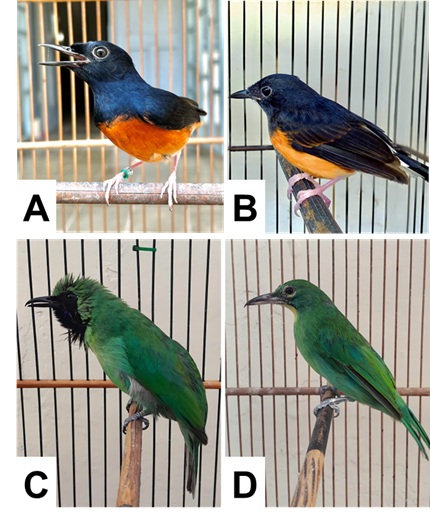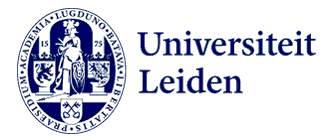Evaluation of molecular primers for sexing the magpie robin and green cucak via CHD1 gene amplification
DOI:
https://doi.org/10.46549/jipvet.v15i2.557Keywords:
Accuracy, Bird, PCR sexing, Primer, SelectionAbstract
Researchers and breeders are increasingly using the Polymerase Chain Reaction (PCR) method for bird sexing. However, the compatibility of the DNA template and the oligo primer used is the primary key to the success of PCR amplification. In the present study, we evaluated five types of popular PCR primers sexing to determine the sex of a pair of each the magpie robin (Copsychus malabaricus) and green cucak (Chloropsis sonnerati). We used DNA samples from each pair of males and females from the two species above, respectively, to test the five primers listed to amplify the target gene chromodomain helicase DNA binding 1 (CHD1). The results demonstrated that the primer sets of CHD1LF/CHD1LR, CHD1F/CHD1R, and P2/P8 could be used for Copsychus malabaricus, while only CHD1LF/CHD1LR was suitable for Chloropsis sonnerati. It is crucial to select the correct primer to improve bird sexing accuracy because several of the other primers examined in this study were unable to amplify the targeted CHD1 gene correctly.
Downloads
References
Adisti AA, Zulfikhar R. 2021. Mengenal berbagai macam burung di Indonesia. Repository Jurnal Polbangtan Yoma. 2(1):1–36.
Akrom AM, Indarjulianto S, Yanuartono Y, Susmiati T, Nururrozi A, Raharjo S, Permana RGS, Sitompul YY. 2020. Swab bukal sebagai bahan sexing piyikan burung kenari (Serinus canaria) dan burung merpati (Columba livia). Jurnal Sain Veteriner. 38(1):31–36. https://doi.org/10.22146/jsv.49032
Davitkov D, Vučićević M, Glavinić U, Skadric I, Nešić V, Stevanović J, Stanimirović Z. 2021. Potential of inter and intra species variability of CHD1 gene in birds as a forensic tool. Acta Veterinaria Beograd. 71(2):147–157. https://doi.org/10.2478/acve 2021 0013
Dobreva MP, Lynton Jenkins JG, Chaves JA, Tokita M, Bonneaud C, Abzhanov A. 2021. Sex identification in embryos and adults of Darwin’s finches. PLoS One. 16(3):e0237687. https://doi.org/10.1371/journal.pone.0237687
Elnomrosy SM, Hagag NM, AbdAllah MI, Kolenda R, Zacharski M. 2022. Application of Loop Mediated Isothermal Amplification (LAMP) in sex identification of parrots bred in Egypt. Biology. 11(4):565. https://doi.org/10.3390/biology11040565
Fitriana F, Resita R, Disastra Y, Setyorini DR, Haryanto A, Aziz F. 2023a. Evaluation of primers targeting chromo helicase DNA binding gene (CHD) for molecular sexing identification in four bird families. Livest Anim Res. 21(1):14–20. https://doi.org/10.20961/lar.v21i1.66998
Fitriana F, Setyorini DR, Artdita CA, Ummami R, Haryanto A, Aziz F. 2023b. Comparison of four types molecular sexing primers in different bird families. Journal of Tropical Animal and Veterinary Science. 13(1):51–57. https://doi.org/10.46549/jipvet.v13i1.359
Fridolfsson A K, Ellegren H. 1999. A simple and universal method for molecular sexing of non ratite birds. J Avian Biol. 30(1):116–121. https://doi.org/10.2307/3677252
Gebhardt KJ, Waits LP. 2008. High error rates for avian molecular sex identification primer sets applied to molted feathers. J Field Ornithol. 79(3):286–292. https://doi.org/10.1111/j.1557 9263.2008.00175.x
Green MR, Sambrook J. 2019. Polymerase Chain Reaction. CSH Protoc. 2019(6):pdb.top095109. https://doi.org/10.1101/pdb.top095109
Griffiths R, Double MC, Orr K, Dawson RJG. 1998. A DNA test to sex most birds. Molecular Ecology. 7(8):1071–1075. https://doi.org/10.1046/j.1365 294x.1998.00389.x
Iskandar J. 2014. Dilema antara hobi dan bisnis perdagangan burung serta konservasi burung. Chimica et Natura Acta. 2(3):180–185. https://doi.org/10.24198/cna.v2.n3.9165
Khan NW, St John J, Quinn TW. 1998. Chromosome specific intron size differences in the avian CHD gene provide an efficient method for sex identification in birds. The Auk. 115(4):1074–1078. https://doi.org/10.2307/4089527
Kroczak A, Wierzbicki H, Urantówka AD. 2022. The length polymorphism of the 9th intron in the avian CHD1 gene allows sex determination in some species of Palaeognathae. Genes. 13(3):507. https://doi.org/10.3390/genes13030507
Kroczak A, Wołoszyńska M, Wierzbicki H, Kurkowski M, Grabowski KA, Piasecki T, Galosi L, Urantówka AD. 2021. New bird sexing strategy developed in the order Psittaciformes involves multiple markers to avoid sex misidentification: debunked myth of the universal DNA marker. Genes. 12(6):878. https://doi.org/10.3390/genes12060878
Lee JCI, Tsai LCT, Hwa PY, Chan CL, Huang A, Chin SC, Wang LC, Lin JT, Linacre A, Hsieh HM. 2010. A novel strategy for avian species and gender identification using the CHD gene. Mol Cell Probes. 24(1):27–31. https://doi.org/10.1016/j.mcp.2009.08.003
Liang S, Chen M, Gao C, Yan H, Zhang G, Wang X. 2019. Sex identification of pigeons using polymerase chain reaction analysis with simple DNA extraction. Avian Biology Research. 12(2):45–48. https://doi.org/10.1177/1758155919832141
Molle MNV, Maker UP, Kilmaskossu A. 2019. Jenis jenis burung kicau dan aspek konservasinya pada komunitas kicau mania Manokwari. Vogelkop: Jurnal Biologi. 2(1):21–27. https://doi.org/10.30862/vogelkopjbio.v2i1.43
Pamulang YV, Haryanto A. 2021. Short communication: molecular bird sexing on kutilang (Pycnonotus sp.) based on amplification of CHD Z and CHD W genes by using PCR method. Biodiversitas. 22(1):449–452. https://doi.org/10.13057/biodiv/d220155
Purwaningrum M, Nugroho HA, Asvan M, Karyanti K, Alviyanto B, Kusuma R, Haryanto A. 2019. Molecular techniques for sex identification of captive birds. Vet World. 12(9):1506–1513. https://doi.org/10.14202/vetworld.2019.1506 1513
Putranto HD, Okvianto D, Prakoso H. 2018. Studi reproduksi burung murai batu (Copsychus malabaricus) pada penangkaran lokal di Kota Bengkulu. Jurnal Sain Peternakan Indonesia. 13(2):130–139.
Ramos CN, Barros TB, de Antonio ES, Mirabal B, da Silva MB, Fraga RE, Tomazi L. 2021. Sexing as a tool for reinsertion of Amazona aestiva parrots to nature: use of less invasive technique. Research Society and Development. 10(12):e380101220601. https://doi.org/10.33448/rsd v10i12.20601
Savitri D, Putri I, Nugrahani WP, Purwaningrum M, Haryanto A. 2021. Molecular bird sexing of sulphur crested cockatoo (Cacatua galerita) by PCR method. Indonesian Journal of Biotechnology. 26(1):1–6. https://doi.org/10.22146/ijbiotech.54611
Setiadi A. 2023. Konservasi keanekaragaman hayati endemik melalui ecology, socio economic, dan socio cultural approach (studi pada Taman Kehati Kokolomboi, Sulawesi Tengah). Learning Society: Jurnal CSR, Pendidikan dan Pemberdayaan Masyarakat. 4(1):244–254. https://doi.org/10.30872/ls.v4i1.2313
Turcu MC, Bel LV, Collarile T, Pusta DL. 2020. Comparative evaluation of two techniques of sex determination in lovebirds (Agapornis spp.). Bull Univ Agric Sci Vet Med Cluj Napoca. 77(2):106–114. https://doi.org/10.15835/buasvmcn vm:2020.0030
van der Velde M, Haddrath O, Verkuil YI, Baker AJ, Piersma T. 2017. New primers for molecular sex identification of waders. Wader Study. 124(2):147–151. https://doi.org/10.18194/ws.00069
Vučićević M, Stevanov Pavlovic M, Stevanovic J, Bosnjak J, Gajic B, Aleksic N, Stanimirovic Z. 2013. Sex determination in 58 bird species and evaluation of CHD gene as a universal molecular marker in bird sexing. Zoo Biol. 32(3):269–276. https://doi.org/10.1002/zoo.21010
Yuda P, Saputra AW. 2021. Eggshell membrane for DNA sexing of the endangered Maleo (Macrocephalon maleo). F1000Res. 9:599. https://doi.org/10.12688/f1000research.23712.4

Downloads
Published
How to Cite
Issue
Section
License
Copyright (c) 2025 Khilmi Fuadah, Anisa Rahmawati, Fauziah Fitriana, Fatkhanuddin Aziz

This work is licensed under a Creative Commons Attribution-NonCommercial-ShareAlike 4.0 International License.
License and Copyright Agreement
In submitting the manuscript to the journal, the authors certify that:
- They are authorized by their co-authors to enter into these arrangements.
- The work described has not been formally published before, except in the form of an abstract or as part of a published lecture, review, thesis, or overlay journal. Please also carefully read Jurnal Ilmu Peternakan dan Veteriner Tropis (Journal of Tropical Animal and Veterinary Science) Posting Your Article Policy at https://journal.fapetunipa.ac.id/index.php/JIPVET/publicationethics
- That it is not under consideration for publication elsewhere,
- That its publication has been approved by all the author(s) and by the responsible authorities “tacitly or explicitly“ of the institutes where the work has been carried out.
- They secure the right to reproduce any material that has already been published or copyrighted elsewhere.
- They agree to the following license and copyright agreement.
Copyright
Authors who publish with Jurnal Ilmu Peternakan dan Veteriner Tropis (Journal of Tropical Animal and Veterinary Science) agree to the following terms:
- Authors retain copyright and grant the journal right of first publication with the work simultaneously licensed under a Creative Commons Attribution License (CC BY-NC-SA 4.0) that allows others to share the work with an acknowledgment of the work's authorship and initial publication in this journal.
- Authors are able to enter into separate, additional contractual arrangements for the non-exclusive distribution of the journal's published version of the work (e.g., post it to an institutional repository or publish it in a book), with an acknowledgment of its initial publication in this journal.
- Authors are permitted and encouraged to post their work online (e.g., in institutional repositories or on their website) prior to and during the submission process, as it can lead to productive exchanges, as well as earlier and greater citation of published work.

This work is licensed under a Creative Commons Attribution-NonCommercial-ShareAlike 4.0 International License.




























.png)
